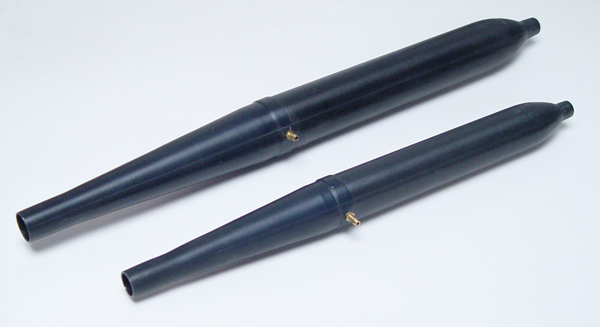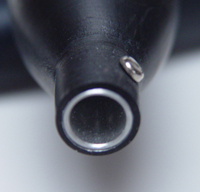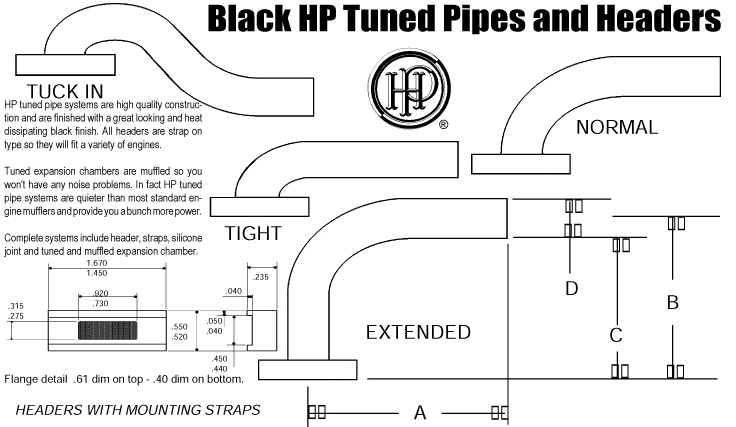|
Black
HP Tuned Pipes and Headers
 |
HP tuned pipe
systems are high quality construction and are finished with
a great looking and heat dissipating black finish. All headers
are strap on type so they will fit a variety of engines.
SPECIAL PRICES
.
|
|
Tuned expansion
chambers are muffled so you won't have any noise problems.
In fact HP tuned pipe systems are quieter than most standard
engine mufflers and provide you a bunch more power.
Weight of the
.40 pipe is 3.7oz and the .61 pipe is 5.5 oz.
|
 |

Tuned
pipe chamber for .40-.46 size part number HP TP40
Tuned
pipe chamber .61 size part number HP TP61
Header
Price includes header, straps. Silicone joint tube extra cost.
Click
for the whole list of HP headers and Pipes 

| STYLE |
New
P/N |
FITS |
OLD
P/N |
A |
B |
C |
D |
Material |
| Tight
|
HPHD-614 |
HP
20, 40, ETC |
66111084 |
4.25
|
1.625* |
1.25 |
16MM
|
Steel |
| Tight |
HPHD-613 |
HP 20, 40, ETC |
66111083 |
4.0 |
1.75* |
1.375 |
16MM
|
Aluminum |
| Tight
|
HPHD-612 |
HP
20, 40, ETC |
66111082 |
4.125 |
1.0 |
0.7* |
16MM
|
Aluminum |
| Normal |
HPHD-622 |
HP
20, 40, ETC |
66211082 |
4.5 |
2.625* |
2.25 |
16MM
|
Aluminum |
| Normal
|
HPHD-624
|
HP
20, 40, ETC |
66211084
|
4.25 |
2.625*
|
2.25 |
16MM
|
Steel |
| Extended |
HPHD-625
|
HP
20, 40, ETC |
66211085
|
4.5 |
3.5 |
3.25* |
16MM |
Steel |
| Extended |
HPHD-623 |
HP
20, 40, ETC |
66211083 |
4.25 |
4.25 |
4.00 |
16MM |
Aluminum |
| |
|
|
|
|
|
|
|
|
| Normal
|
HPHD-822 |
HP
20, 40, ETC |
86211082 |
4.25 |
2.75 |
2.5* |
18MM |
Aluminum |
| Normal |
HPHD-815 |
HP
20, 40, ETC |
86111085 |
4.25 |
2.75 |
2.5 |
18MM |
Steel |
| Extended
|
HPHD-818 |
HP
20, 40, ETC |
86111088 |
4.25
|
3.5 |
3.125* |
18MM
|
Steel |
| Extended
|
HPHD-823 |
HP
20, 40, ETC |
86211083 |
4.5 |
3.5 |
3.125* |
18MM |
Aluminum |
| Extended
|
HPHD-825 |
HP
20, 40, ETC |
86211085 |
4.25 |
3.525 |
3.275 |
18MM |
Steel |
| |
|
|
|
|
|
|
|
|
| Tuck
in |
HPHD-686
|
HP
61, HB 61, OS FSR 61, ETC |
66311086
|
4.75 |
-1.00 |
|
19MM |
Aluminum |
| Normal |
HPHD-834 |
HP
61, HB 61, OS FSR 61, ETC |
86311084 |
4.25 |
2.625 |
2.2 |
20MM |
Aluminum |
| Extended |
HPHD-935 |
HP
61, HB 61, OS FSR 61, ETC |
96311085 |
4.25 |
3.375* |
3.00 |
20MM |
Steel |
All measurements are approximate.
|
Instructions
on
HOW TO TUNE A TUNED PIPE
|
| |
|
The
HP TUNED PIPE SILENCER offers good exhaust muffling combined
with considerable power increase to satisfy both environment
protection considerations and the modelers demand for more
power. In the 12.000-16.000 R.P.M. range, the HP TUNED PIPE
SILENCER gains up to 1700 R.P.M. for your HP engine when compared
to the standard silencer and up to 1000 R.P.M. when compared
to the engine without silencer. The power increase is achieved
by making better use of the combustible mixture.
Working principle of the tuned pipe... When the engine is
operated with a standard silencer or without silencer, losses
of unburnt mixture during the exhaust stroke occur. Therefore,
the ensuing working stroke can use only the remaining part
of the mixture to produce power. In the tuned pipe, cyclic
pressure waves develop due to reflection of the exhaust gases
by a baffle. During this "supercharging" process, unburnt
mixture normally lost through the exhaust is returned into
the combustion chamber thus improving the volumetric efficiency
of the engine. The HP TUNED PIPE SILENCER yields this effect
even without being matched to the operating conditions. For
obtaining the full potential power gain, however, it is necessary
to tune the ENGINE-TUNED PIPE SILENCER system precisely to
existing operating conditions This is easily achieved by adjusting
the manifold length. The HP manifolds are delivered with excessive
length, and have to be shortened to suit the operating conditions.
|
| |
 |
TUNING
THE HP TUNED PIPE SILENCER |
| |
For
tuning, a precision tachometer and two props of the
same type with identical diameter, but with pitch differing
by about one inch, are needed, for example.
For .61 engines --- 11x6 and 11x7 or 11x7 and 11x7.75
For .40 engines --- 10x5 and 10x6
In flight, the engine's speed is higher by about 1000
R.P.M. (depending on the model's velocity) when compared
to a static R.P.M. with identical prop. For exact
tuning on the bench, a prop should be used which has
static R.P.M. coinciding with flight R.P.M. of the
prop to be used on the model (for example, if 11 x
7 is the flight prop, use an 11 x 6 for tuning). When
cutting down the manifold outlet (in 1/4" steps),
R.P.M. will go up gradually. When no additional R.P.M.
increase occurs, the length of the system is correct.
Any further shortening of the manifold will decrease
R.P.M.
Small deviations from the correct length can be compensated
by adjusting the silicone tube, which also depends
on the type and brand of propeller. The graph shows
the principal form of the power curve.
|
|
|





